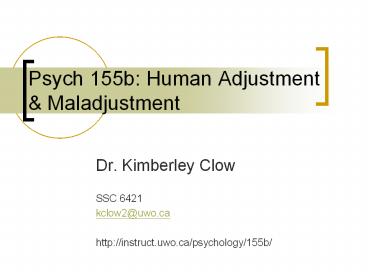Psych 155b: Human Adjustment PowerPoint PPT Presentation
1 / 30
Title: Psych 155b: Human Adjustment
1
Psych 155b Human Adjustment Maladjustment
- Dr. Kimberley Clow
- SSC 6421
- kclow2_at_uwo.ca
- http//instruct.uwo.ca/psychology/155b/
2
Read Your Course Outline!
- Cant have antirequisites
- Psych 150, 251E, 253E, 257E, 350F/G
- Textbook
- Sue, Sue, Sue (2003). Understanding Abnormal
Behaviour. 7th Edition - TA Jennie Ward
- Contact Jennie to go over exams
- jward9_at_uwo.ca
3
Evaluation
- 3 exams
- Test1 and Test2
- 30 each Non-Cumulative
- Final Exam
- 40 Cumulative
- 4 Grading options
- Test1 30 Test2 30 Final 40
- No Test1 Test2 30 Final 70
- Test1 30 no Test2 Final 70
- No Test1 no Test2 Final 100
- Your grade is calculated in all 4 ways and I take
the option that works BEST for you
4
Lecture Overheads
http//instruct.uwo.ca/psychology/155b/
- Lecture overheads are available on the class
website BEFORE class - Print them out and bring them to class
- Spend class time TAKING NOTES on the details I
talk about that arent in the overheads - The overheads are not a replacement for coming to
class - Just using the overheads is not sufficient
preparation for exams - They are tools to help you take BETTER notes not
a replacement for note taking
5
Lecture Schedule
Date Topic Chapter
January 5 Introduction 1
January 12 Theoretical Approaches 2
January 19 Anxiety Disorders 5
January 26 Mood Disorders 11
February 2 Test 1
February 9 Schizophrenia 13
February 16 Personality Disorders 8
February 23 Reading Week N/A
March 1 Dissociative Disorders 6
March 8 Somatoform Disorders 6
March 15 Test 2
March 22 Eating Disorders 16
March 29 Mental Disorders Aging 15
April 5 Law Ethics 18
Exam Period Final Exam
6
Abnormal Psychology
- The scientific study of abnormal behaviour, with
the objective to - Describe
- Explain
- Predict
- Control
- So what are abnormal behaviours?
7
The Movies
8
Myths of Abnormal Behaviour
- The following are common myths about those
suffering from mental illness - Easily recognized as deviant
- Disorder due to inheritance
- Incurable
- Weak willed
- Never contribute to society
- Always dangerous
9
What is Abnormal Behaviour?
- Abnormal behaviour departs from some norm and
harms the affected individual or others - Conceptual Definitions
- Practical Definitions
- Surgeon General DSM-IV Definitions
10
Conceptual Definitions
- Statistical Deviation
- Deviations from Ideal Mental Health
- Multicultural Perspectives
- Cultural Universality
- Cultural Relativism
11
Practical Definitions
- The 4 Ds
- Discomfort
- Deviance
- Dysfunction
- Danger
12
Surgeon General DSM-IV
- A clinically significant behavioural or
psychological syndrome or pattern that occurs in
an individual and that is associated with present
distress (e.g., a painful symptom) or disability
(i.e., impairment in one or more important areas
of functioning) or with a significantly increased
risk of suffering death, pain, disability, or an
important loss of freedom
13
History
- Ancient Beliefs
- Demonology
- Exorcism
- Trephining
- Naturalistic Explanations
- Hippocrates
- Four Humours
- Return to the Supernatural
- Mass Madness
- Tarantism
- Witchcraft
14
Reforms
- Humanism
- People are sick not possessed
- Need to be treated with dignity
- Reform Movements
- Moral Treatment
- Shift from prison to hospital
- Biological View
- Organic explanation for abnormal behaviour
- Drug revolution
15
Frequency of Mental Disorders
16
Psychology Student Syndrome
- Many psych students find that the various
disorders apply to them - Abnormal behaviour is not qualitatively different
from normal behaviour - Many of us will exhibit similar symptoms
- Behaviours are only problematic when they harm or
interfere with your daily functioning - Diagnosing friends and romantic partners may lead
to conflict
17
Mental Health Professions
- Who studies abnormal behaviour?
- Clinical Psychologist
- Ph.D. and internship
- Psychiatrist
- M.D. and internship
- School Psychologist
- M.A. or Ph.D.
- Social Worker
- M.S.W.
18
Who Do People Go See?
19
Diversity Multiculturalism
- Social Conditioning
- e.g., gender stereotypes
- Cultural Values
- Interpret complaints with culture in mind
- Sociopolitical Influences
- Different experiences affect what is abnormal
- Bias in diagnosis
20
Diagnosing Abnormal Behaviour
- Multiaxial approach
- Clinical disorders
- Personality disorders
- General medical conditions
- Psychosocial environmental problems
- Level of current functioning
21
An Example of Classification
- Mark
- Axis I Clinical Disorder
- Alcohol Abuse
- Axis II Personality Disorder
- Paranoid
- Axis III General Medical Condition
- Cirrhosis
- Axis IV Psychosocial Environmental Problems
- Problems with primary support group (divorce)
- Occupational problems
- Axis V Level of Current Functioning
- 54 (moderate difficulty in social occupation
functioning)
22
Interrater Reliability
23
Issues of Classification
- Hinders
- By stigmatizing patients
- Because different labels can mean different
things to different people - By biasing how we see the patient
- By focusing on one point in the patients
development - Patient may outgrow the label
- Helps
- To making treatment decisions
- To communicate among clinicians
- Research
- advancing knowledge of disorders
- diagnosis as a first step to understanding
mechanisms and developing treatments
24
Assessment
- Observation
- Self-Report Inventories
- Biological Measures
- Psychophysiological Measures
- Neuroimaging Techniques
- Projective Tests
- Rorschach Ink Blots
- Thematic Apperception Test (TAT)
25
Rorschach Ink Blots
26
(No Transcript)
27
Scoring
- Look at the following factors
- Location
- Determinants
- Popularity of response
- Content
- Form
- Generate hypotheses based on patterns of
responses, recurrent themes, and
interrelationships among scoring categories
28
Thematic Apperception Test - TAT
29
(No Transcript)
30
Interpretation
- Murrays concepts
- Need
- Press
- Thema
- Basic Assumptions
- Person is identifying with the protagonist in the
story - They are projecting their personality onto the
protagonist

